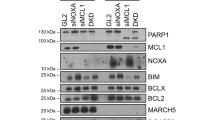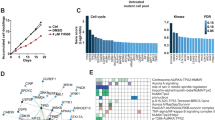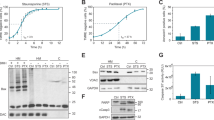Abstract
Rapamycin, a specific inhibitor of the serine/threonine mTOR kinase, markedly inhibited both cell growth and apoptosis in human B-cell lines. Besides arresting cells in G1 by increasing p27kip1, rapamycin tripled the cellular level of the BCL-2 protein. The activity was dose-dependent and specific for the p27kip1 and BCL-2 proteins. Rapamycin did not affect bcl-2 mRNA although it increased cellular BCL-2 concentration by inhibiting phosphorylation, a mechanism initiating the decay process. To add new insight, we combined rapamycin treatment with treatment by taxol, which, by damaging microtubules, can phosphorylate BCL-2 and activate apoptosis. It was found that the mTOR kinase was activated in cells treated with taxol or with nocodazole although it was inhibited in cells pre-treated with rapamycin. BCL-2 phosphorylation, apoptosis and hyperdiploidy were also inhibited by rapamycin. In contrast, taxol-induced microtubule stabilization or metaphase synchronization were not inhibited by rapamycin. Taken together, these findings indicate that mTOR belongs to the enzymatic cascade that, starting from damaged microtubules, phosphorylates BCL-2. By regulating apoptosis, in addition to the control of a multitude of growth-related pathways, mTOR plays a nodal role in signaling G1 and G2-M events.
This is a preview of subscription content, access via your institution
Access options
Subscribe to this journal
Receive 50 print issues and online access
$259.00 per year
only $5.18 per issue
Buy this article
- Purchase on Springer Link
- Instant access to full article PDF
Prices may be subject to local taxes which are calculated during checkout








Similar content being viewed by others
References
Abraham RT . 1998 Curr. Opin. Immunol. 10: 330–336
Adams JM, Cory S . 1991 Science 254: 1161–1167
Aiello A, Delia D, Borrello MG, Biassoni D, Giardini R, Fontanella E, Pezzella F, Pulford K, Pierotti M, Della Porta G . 1992 Cytometry 13: 502–509
Alessandrini A, Chiaur DS, Pagano M . 1997 Leukemia 11: 342–345
Bakhshi A, Jensen JP, Goldman P, Wright JJ, McBride OW, Epstein AL, Korsmeyer SJ . 1985 Cell 41: 899–906
Bickle M, Delley PA, Schmidt A, Hall MN . 1998 EMBO J. 17: 2235–2245
Blagosklonny MV, Fojo T . 1999 Int. J. Can. 83: 151–156
Blagosklonny MV, Schulte T, Nguyen P, Trepel J, Neckers LM . 1996 Cancer Res. 56: 1851–1854
Brunn GJ, Fadden P, Haystead TAJ, Lawrence Jr JC . 1997 J. Biol. Chem. 272: 32547–32550
Brunn GJ, Hudson CC, Sekulic A, Williams JM, Hosoi H, Houghton PJ, Lawrence Jr JC, Abraham RT . 1997 Science 277: 99–101
Capaccioli S, Quattrone A, Schiavone N, Calastretti A, Copreni E, Bevilacqua A, Canti G, Gong L, Morelli S, Nicolin A . 1996 Oncogene 13: 105–115
Chadebech P, Brichese L, Baldin V, Vidal S, Valette A . 1999 Biochem. Biophys. Res. Comm. 262: 823–827
Choi JH, Adames NR, Chan T, Zeng C, Cooper JA, Zheng XFS . 2000 Curr. Biol. 10: 861–864
Cleary ML, Smith SD, Sklar J . 1986 Cell 47: 19–28
Cordon-Cardo C, Koff A, Drobnjak M, Capodieci P, Osman I, Millard SS, Gaudin PB, Fazzari M, Zhang ZF, Massague J, Scher HI . 1998 J. Natl. Cancer Inst. 90: 1284–1291
Crossin KL, Carney DH . 1981 Cell 27: 341–350
Dyer MJ, Fischer P, Nacheva E, Labastide W, Karpas A . 1990 Blood 75: 709–714
Guo M, Bruce AH . 1999 Curr. Opin. Cell Biol. 11: 745–752
Haldar S, Basu A, Croce CM . 1997 Cancer Res. 57: 229–233
Haldar S, Chintapalli J, Croce CM . 1996 Cancer Res. 56: 1253–1255
Hara K, Yonezawa K, Weng QP, Kozlowski MT, Belham C, Avruch J . 1998 J. Biol. Chem. 273: 14484–14494
Hashemolhosseini S, Nagamine Y, Morley SJ, Desrivieres S, Mercep L, Ferrari S . 1998 J. Biol. Chem. 273: 14424–14429
Itano Y, Ito A, Uehara T, Nomura Y . 1996 J. Neurochem. 67: 131–137
Kitamura Y, Kosaka T, Shimohama S, Nomura Y, Taniguchi T . 1997 Jpn. J. Pharm. 75: 195–198
Kluin-Nelemans HC, Limpens J, Meerabux J, Beverstock GC, Jansen JH, De Jong D, Kluin PM . 1991 Leukemia 5: 221–224
Koff A, Polyak K . 1995 Prog. Cell Cycle Res. 1: 141–147
Konig A, Schwartz GK, Mohammad RM, Al-Katib A, Gabrilove JL . 1997 Blood 90: 4307–4312
Korsmeyer SJ . 1998 Trends Genet. 11: 101–105
Korsmeyer SJ, McDonnell TJ, Nunez G, Hockenbery D, Young R . 1990 Curr. Top. Microbiol. Immunol. 166: 203–207
Kroemer G . 1997 Nat. Med. 3: 614–620
Jansen B, Wacheck V, Heere-Ress E, Schlagbauer-Wadl H, Hoeller C, Lucas T, Hollenstein U, Wolff K, Pehamberger H . 2000 Lancet 356: 1728–1733
Laemmli UK . 1970 Nature 227: 680–685
Li F, Ambrosini G, Chu EY, Plescia J, Tognin S, Marchisio PC, Altieri DC . 1998 Nature 396: 580–584
Lundberg AS, Weinberg RA . 1999 Eur. J. Cancer 35: 1886–1894
McDonnell TJ, Beham A, Sarkiss M, Andersen MM, Lo P . 1996 Experientia 52: 1008–1017
Metcalfe SM, Canman CE, Milner J, Morris RE, Goldman S, Kastan MB . 1997 Oncogene 15: 1635–1642
Migita K, Eguchi K, Ichinose Y, Kawabe Y, Tsukada T, Aoyagi T, Nagataki S . 1997 Clin. Exper. Immunol. 108: 199–203
Morelli S, Alama A, Quattrone A, Gong L, Copreni E, Canti G, Nicolin A . 1996 Anti Cancer Drug Des. 11: 1–14
Morelli S, Delia D, Capaccioli S, Quattrone A, Schiavone N, Bevilacqua A, Tomasini S, Nicolin A . 1997 Proc. Natl. Acad. Sci. USA 94: 8150–8155
Mosmann T . 1983 J. Immunol. Meth. 65: 55–63
Nakayama K, Nakayama K, Negishi I, Kuida K, Shinkai Y, Louie MC, Fields LE, Lucas PJ, Stewart V, Alt FW, Loh DY . 1993 Science 261: 1584–1588
Nave BT, Ouwens M, Withers DJ, Alessi DR, Shepherd PR . 1999 Biochem. J. 344: 427–431
Nicoletti I, Migliorati G, Pagliacci MC, Grignani F, Riccardi C . 1991 J. Immunol. Met. 139: 271–279
Pratesi G, Polizzi D, Perego P, Dal Bo L, Zunino F . 2000 Biochem. Pharmacol. 60: 77–82
Reed JC, Miyashita T, Takayama S, Wang HG, Sato T, Krajewski S, Aime-Sempe C, Bodrug S, Kitada S, Hanada M . 1996 J. Cell. Biochem. 60: 23–32
Saille C, Marin P, Martinou JC, Nicole A, London J, Ceballos-Picot I . 1999 Neurosci. 92: 1445–1463
Schiff PB, Horwitz SB . 1980 Proc. Natl. Acad. Sci. USA 77: 1561–1565
Schmelzle T, Hall MN . 2000 Cell 103: 253–262
Schmidt A, Beck T, Koller A, Kunz J, Hall MN . 1998 EMBO J. 17: 6924–6931
Sehgal SN . 1998 Clin. Biochem. 31: 335–340
Siegel DS, Zhang X, Feinman R, Teitz T, Zelenetz A, Richon VM, Rifkind RA, Marks PA, Michaeli J . 1998 Proc. Natl. Acad. Sci. USA 95: 162–166
Silvestrini R, Veneroni S, Daidone MG, Benini E, Boracchi P, Mezzetti M, Di Fronzo G, Rilke F, Veronesi U . 1994 J. Natl. Cancer Inst. 86: 499–504
Srivastava RK, Mi QS, Hardwick JM, Longo DL . 1999 Proc. Natl. Acad. Sci. USA 96: 3775–3780
Steube KG, Jadau A, Teepe D, Drexler HG . 1995 Leukemia 9: 1841–1846
Stewart ZA, Leach SD, Pietenpol JA . 1999 Mol. Cell. Biol. 19: 205–215
Strasser A, Harris AW, Bath ML, Cory S . 1990 Nature 348: 331–333
Terada N, Takase K, Papst P, Nairn AC, Gelfand EW . 1995 J. Immunol. 155: 3418–3426
Tsujimoto Y, Finger LR, Yunis JJ, Nowell PC, Croce CM . 1984 Science 226: 1097–1099
Veis DJ, Sorenson CM, Shutter JR, Korsmeyer SJ . 1993 Cell 75: 229–240
Vlach J, Hennecke S, Amati B . 1997 EMBO J. 16: 5334–5344
Webb A, Cunningham D, Cotter F, Clarke PA, Di Stefano F, Ross P, Corbo M, Dziewanowska Z . 1997 Lancet 349: 1137–1141
Yamamoto K, Ichijo H, Korsmeyer SJ . 1999 Mol. Cell. Biol. 19: 8469–8478
Acknowledgements
We thank Dr JC Lawrence for the Tab1 and Tab2 antibodies, Dr F Navone for the assistance in microtubule staining, Dr P Castagnoli and Dr A Costa for assistance in the flow cytometry and Prof R Silvestrini for assistance in the mitotic index. Finally, we thank Drs D Delia, JC Lawrence and A Quattrone for invaluable suggestions. This work was supported by grants from AIRC, Milan; CNR, Project ACRO; MURST and Istituto Superiore di Sanità, Rome.
Author information
Authors and Affiliations
Corresponding author
Rights and permissions
About this article
Cite this article
Calastretti, A., Bevilacqua, A., Ceriani, C. et al. Damaged microtubules can inactivate BCL-2 by means of the mTOR kinase. Oncogene 20, 6172–6180 (2001). https://doi.org/10.1038/sj.onc.1204751
Received:
Revised:
Accepted:
Published:
Issue Date:
DOI: https://doi.org/10.1038/sj.onc.1204751
Keywords
This article is cited by
-
Phosphorylation of AKT pathway proteins is not predictive of benefit of taxane therapy in early breast cancer
Breast Cancer Research and Treatment (2013)
-
CD40L induces multidrug resistance to apoptosis in breast carcinoma and lymphoma cells through caspase independent and dependent pathways
BMC Cancer (2006)
-
Current development of mTOR inhibitors as anticancer agents
Nature Reviews Drug Discovery (2006)
-
When translation meets transformation: the mTOR story
Oncogene (2006)
-
Characterization of vinblastine-induced Bcl-xL and Bcl-2 phosphorylation: evidence for a novel protein kinase and a coordinated phosphorylation/dephosphorylation cycle associated with apoptosis induction
Oncogene (2005)



